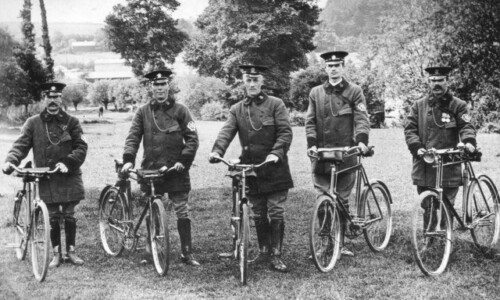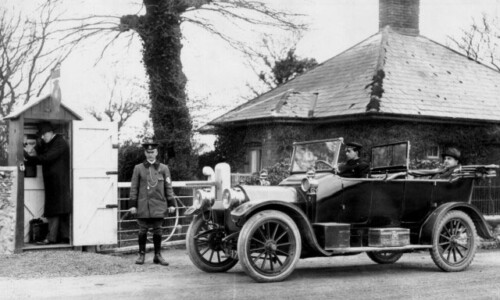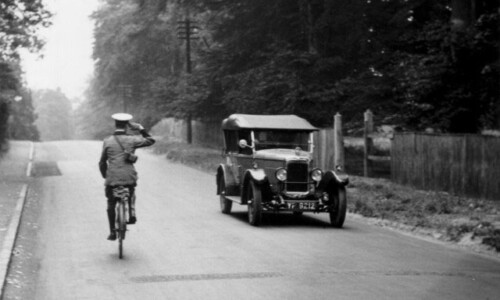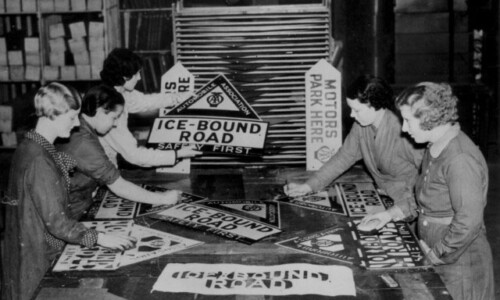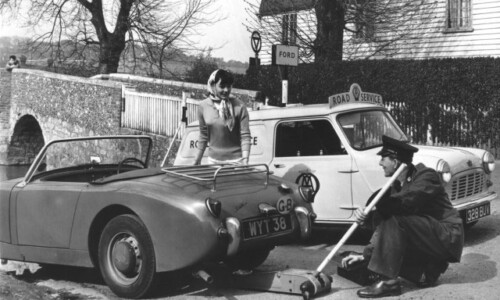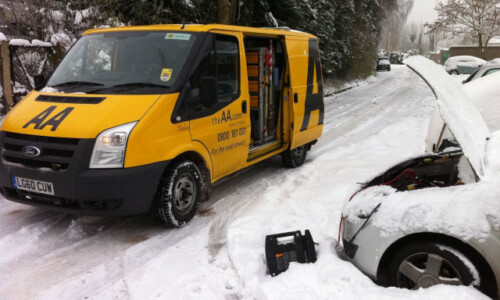The early days of The AA were born out of the development of the motor car, or locomotive as they were called in those days, as early as 1896 with the Emancipation Act which allowed locomotives to travel without vehicles being preceded by a man with a red flag at a maximum of 4 mph. This led to locomotives exceeding the new 14 mph speed limit and the police taking action and prosecuting many motorists. The 1903 Act increased the speed limit to 20 mph but still the police used their powers to prosecute motorists. Typically the policemen would crouch behind the hedgerows, tortured perhaps by flies or other insects or maybe enchanted by a pink mist of wild rose petals, but in their hands were stopwatches waiting hungrily for the speeding unsuspecting motorist to exceed 22.5 mph over a measured furlong (660 feet or 201 metres) then being stopped by a second hidden policeman. This generated widespread bitterness around the country with all motorists, it was discovered also that not all prosecutions were fair, policemen using inaccurate stop watches along with inaccurate measured distances. Before long there was enmity amongst the motorists instead of friendliness and the motor car was under a cloud which was more serious than the cloud of dust they left behind as they travelled the poor roads of the day. By the end of 1904 two well-known intrepid motorists, Charles Jarrott (he won the 320 mile 1902 Circuit des Ardennes race in a 70 hp Panhard) and William Letts the MD of the Locomobile Co of GB and a pioneer of the light steam car in GB (partners in the firm Charles Jarrott and Letts) were operating a private warning system on certain stretches of the Brighton road. In March 1905 The Autocar printed a letter about motorists’ grievances by a young theatrically minded gentleman named Walter Gibbons. In his letter he forthrightly proposed a club should be formed to prevent speed traps. His idea was that a group of cyclists wearing special arm badges, and paid from the club’s annual subscriptions, should be engaged to discover the traps and give the motorists warning. Jarrott and Letts were recruited along with a number of sympathisers and by the end of April that year they were in a position to call themselves the Automobile Mutual Association. Events now moved at a pace and by 29 June 1905 the executive body of this group renamed themselves The Automobile Association. At this time there were some who saw the system of warning motorists of police traps as ‘proceeding of questionable dignity’ and suggested that the ‘published propaganda of the new association’ could be better dealt with by the already established group called The Motor Union. This did not go down well with the AA.
At this time a young man of thirty was in London, his name Stenson Cooke, needed to see his friend Charles Gulliver, who was a temporary secretary of The AA located in their in their loaned office space at Amery-Parkes Solicitors in Fleet Street. Thankfully he managed to see his friend, explaining the reasons why he couldn’t repay his debt. This meeting proved to be a life changer for Stenson Cooke; before he knew where he was he had an interview for the job of Secretary at the AA. By the last week of August 1905 he was appointed as Secretary for the AA, a job he held for 37 years. When he took the job as Secretary the AA membership was 90 members, he propelled The AA to success and by the start of the First World War in 1914 they had 83,000 members.
From the beginning of Stenson Cooke’s tenure he was enthusiastic and energetic and by the end of 1906 the AA were patrolling many roads from Hampshire to Hertfordshire. Their solicitors Amery-Parkes were dealing with cases being brought to court and The AA had to recruit an office typist and office boy to assist with the growing administration. As a further development, with an almost military like campaign, The AA issued their “Scouts” with field glasses to assist them to spot police traps. In addition, AA badges were issued to all patrol cyclists. This was an interesting development; it was a double sided disc worn on the jacket of the patrol (Scout) which was on one side yellow letters (AA) on a white background to indicate all clear, on the reverse it showed AA in black on a red background to indicate that police were in the vicinity. This decision angered some members as they realised that they were paying a subscription of 2 guineas per year but all motorists were receiving the benefit. This led to the decision that all members should display an AA badge on the front of their vehicle provided as part of their membership. This decision was an overwhelming success and membership increased as motorists could immediately see the benefit of membership.
The AA badge became the order of the day as garages with an AA flagpole assisted in the task of identifying police traps. If an AA garage knew of a police trap a yellow ball would be raised to the top of the pole, motorists were encouraged to stop and ask if they had a “message” and they would be advised of the police trap, very clever! The AA was so successful in its entire venture that by the end of 1906 they had a membership of almost 3,000. 1907 was another year of development, they recruited patrols in Lancashire and Yorkshire and by the end of the year the AA had 9,000 members. In that year The AA spent a great deal of money on hundreds of road signs around the country, they also introduced the first AA handbook for members. One of the most memorable events took place on 17 March 1909 when, following an earlier request by the war department (Today’s ministry of defence), the AA mobilised their members to move a battalion of guards from London to Hastings in their cars. This was such a success that from heron the government agreed that motorised transport should be used to transport troops, which almost certainly said goodbye to horseback and infantry as the prime source of troop movement.
By 1909 the relationship between the AA and the police had softened and in 1910 the AA opened offices in Liverpool, Dublin and Belfast. The introduction of illuminated road signs first used in 1909 was growing in use during 1910, at the same time, with a change of management the AA merged with the Motor Union and the much loved sportsman the Earl of Lonsdale became the AA President. He ensured he had a committee behind him which included Charles McWhirter, Walter Gibbons and Charles Jarrott as well as two future Secretaries, Edward Fryer (1942 – 1947) and William Gibson (1947 – 1953) then by the end of 1910 the AA membership had grown to 28,040 members. In 1911 the membership continued to grow with notable new members joining, such as Winston Churchill, the Duchess of Argyll and Prince Maurice of Battenberg and Sir Edward Grey along with many others. Branch offices were opened in Birmingham and Leeds and patrols were wearing blue peaked caps with yellow piping with an AA badge on the front. A first aid kit and a course of instruction was issued to patrols. In that year it was the absence of the salute that would be used to warn of a police speed trap – members were asked to stop and ask the reason whenever a scout failed to salute them, this was the opportunity to warm of a speed trap ahead. 1912 was another phenomenal year for the AA, in April alone 2,691 members were enrolled bringing their total membership to 43,000. Roadside telephone boxes were installed for the first time and patrolmen used them to report on weather conditions. The patrolmen were now respected by the police as they assisted with the detection of stolen vehicles. Another victory for the AA that year was an announcement by the Home Secretary, Reginald McKenna, that speed traps would only be used where driving was considered to be really dangerous. This announcement pleased every one of The AA’s 70,000 members.
The years that followed were all good for the AA, during both world wars they provided patrols as military police to assist the war effort, but even during the years of depression between the two world wars the AA expanded their operation with the issue of members handbooks and in 1920 pioneered the first roadside petrol pumps. By 1923 The AA had 650 cycle (and motorcycle) patrolmen to assist drivers on the road. 1928 saw the introduction of air travel for members with the introduction of maps for Europe and home travel. The 1930 Road Traffic Act was controversial in many ways not least with the introduction of the legal requirement to have third party Insurance for the vehicle you were driving. In 1933 Sir Stenson Cooke was knighted for his work at the AA and service to motoring in particular. In May 1936 the AA celebrated by recruiting it’s 600,000th member with the introduction of a free legal service for AA members. The AA patrolmen had progressed to motorcycle and sidecar to carry out their job and by this time their role had developed to assisting broken down motorists.
From hereon the AA continued to grow and develop as motoring became an everyday part of life, vehicle numbers grew and vehicles were not always so easily fixed at the roadside. One of the most significant developments for The AA was the introduction of the “Relay” service in October 1973 when the AA started to recover vehicles themselves instead of relying upon local garages. This in effect was a major development for the motorist as they were transported anywhere in the country with their vehicle.
Today The AA has grown out of all proportion to those early days with an estimated membership of 2.1 million members worldwide and they continue to offer a service today as they did in 1905.
Denis Bass

